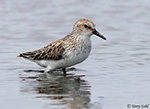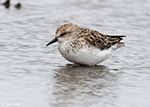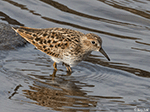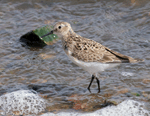| Length: 6 to 7 inches | Wingspan: 12 to 14 inches | Seasonality: Migrant |
| ID Keys: Bill drooped and generally longer than similar Semipalmated and Least Sandpipers,, black legs and feet. Rusty stripe on scapulars in breeding plumage | ||
 The Western Sandpiper is a
very close relative of the Semipalmated
Sandpiper, and the two can be very difficult to differentiate between.
While many can be found on both U.S. coastlines during the winter, they also
migrate southward as far as southern South America. Massive
flocks can be found in key migration stopover sites along the West Coast in the
Fall.
The Western Sandpiper is a
very close relative of the Semipalmated
Sandpiper, and the two can be very difficult to differentiate between.
While many can be found on both U.S. coastlines during the winter, they also
migrate southward as far as southern South America. Massive
flocks can be found in key migration stopover sites along the West Coast in the
Fall.
In South Dakota, Western Sandpipers are rare migrants (recorded sightings in eBird are very sparse), where their similarity in appearance to the much more common Semipalmated Sandpiper may make them an unnoticed visitor.
Habitat:
On summer breeding grounds, Western Sandpipers prefer tundra slopes with a low brush and nearby wetlands. In migration and winter, they can be found on mudflats, sandy beaches, and tidal estuaries.
Diet:
Primarily east insects, spiders, and small crustaceans on its summer breeding grounds. In winter and in migration, diet varies by location, but may include amphipods, small crustaceans and mollusks, marine worms, insects, and seeds.
Behavior:
Forages in shallow water, sandy beaches, or mudflats, walking along and probing in the mud for food, or picking food items directly from the surface.
Breeding:
Non-breeder in South Dakota. On their tundra breeding grounds, male Western Sandpipers arrive first, scouting out potential nesting sites as soon as the snow and ice clear. The males will make a shallow scrape on the tundra, typically in a protected area such as at the base of a small shrub, or a clump of herbaceous vegetation. He'll then try to attract a mate, both through display flights, and in courtship displays on the ground where the male will spread his wings, raise the tail, and call to the female. Females eventually follow the chosen mate to the nesting site, where both birds will help construct a small nesting site of mosses, lichen, grasses, and other vegetation. The female lays 2 to 5 buffy colored eggs with dense dark spotting, and both parents help to incubate them. Once the young hatch, both parent initially tend to the young, but the female leaves before the young fledge from the nest, leaving the male to tend to the young until they become independent.
Song:
During migration in South Dakota, Western Sandpipers are relatively quiet. They're much more vocal on their breeding grounds, with a variety of calls ranging from thin cheet notes, to a loud, scolding chattering.
Migration:
Breeds in Alaska and western Siberia. Winters on both the Atlantic and Pacific coasts of North and South America.
Interactive eBird Map:
Click here to access an interactive eBird map of Western Sandpiper sightings
Similar Species:
Easily confused with Semipalmated Sandpipers, as well as other small sandpipers that may migrate through South Dakota.
- Semipalmated Sandpiper - Leg color differentiates some of these small sandpiper species, but both Semipalmated and Western Sandpipers have black legs. Semipalmated Sandpipers have a shorter, straighter bill, while that of a Western Sandpiper is slightly longer, and appears to droop in the last third of the bill. In fresh breeding plumage, Semipalmated Sandpipers have less colorful plumage on their upperparts, while Western Sandpipers have brighter rusty tones. Semipalmated Sandpipers in breeding plumage have cleaner flanks, while those on a Western Sandpiper usually have chevron-shaped marking. Non-breeding plumaged birds of the two species are more difficult to differentiate. Bill characteristics may be the best bet in that plumage.
- Least Sandpiper - Least Sandpipers have similar bills to that of a Western Sandpiper, but leg color differentiates them, as Least Sandpipers have yellow legs, while Western Sandpipers have black legs.
- Baird's Sandpiper - Baird's Sandpipers are a little larger than the other small sandpipers listed here, but size can be difficult to judge from birds in the field. Baird's Sandpipers also have a straighter, slightly longer bill than a Western Sandpiper, and a brownish wash across the breast with spots, compared to a white breast with spots on a Western Sandpiper.
 |
 |
 |
 |
| Semipalmated Sandpiper | Semipalmated Sandpiper | Least Sandpiper | Baird's Sandpiper |
Conservation Status:
Generally abundant, but vulnerable to declines from habitat loss due to its preference for a few key stopover points during migration. While declines may currently be underway, the IUCN currently lists the Western Sandpiper to be a species of "Least Concern".
Further Information:
Photo Information:
Photo courtesy of Mick Thompson. Taken near Nome, Alaska in June, 2017.
Additional Photos:
Click on the image chips or text links below for additional, higher-resolution Western Sandpiper photos.
Audio File Credits:
- 1Andrew Spencer. Recorded in the Nome Census Area of Alaska, on May 23rd, 2013. Original recording and information available on xeno-canto
- 2Andrew Spencer. Recorded in the Nome Census Area of Alaska, on May 23rd, 2013. Original recording and information available on xeno-canto
- 3Tayler Brooks. Recorded in Grant County, Washington on August 29th, 2009 . Original recording and information available on xeno-canto
| Click on the map below for a higher-resolution view |
 |
| South Dakota Status: Casual migrant. Status is difficult to determine in the state, given the extreme difficulty in differentiating Western Sandpipers from the more common species that migrate through the state. |
Additional Western Sandpiper Photos (coming soon!)
